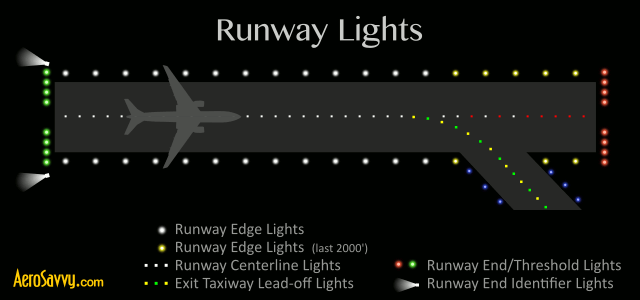
Airport lighting is used at the majority of airports for night operation. Airports use a standardized lighting system, so they are all the same, especially for runway and taxiway lighting. In this section we will discuss the lighting system.
Airport Beacons
Approach Light Systems
Runway & Taxiway lights
Control of Airport Lights
Airport Beacons
Beacon lights are used to help identify an airport and the type of airport at night.
The beacons are operated from dusk until dawn but may also be operated during the day if the ceiling is less than 1,000 feet and or the ground visibility is less than 3 statute miles (VFR minimums).

There is no requirement for an airport to turn on the beacon, if the weather is below VFR minimums. Airport beacon lights are effective from 1° – 10° above the horizon,
but can also be seen from miles away and from high altitudes.
On sectional charts the star symbol indicates the existence of a rotating airport beacon. Larger airport symbols, the star also shows the location of the beacon light.

There are a few different combinations of light colors to identify the type of airport.
Civilian land airport - flashing white and green.
Military - two quick flashing white with a green flash
Heliport - flashing white, yellow and green.
Water airport (seaport) - flashing white and yellow.

Approach Light Systems
Approach lights are used to transition from an instrument approach to a visual approach and are used to aid pilots during a night VFR approach to landing. There are a couple different types of systems, two of which are the main styles of approach light systems that you as a pilot will see in the majority of your flying, they are:
Visual Approach Slope Indicator (VASI)
Precision Approach Path Indicator (PAPI)
Visual Approach Slope Indicator (VASI) - system gives a glide path, using a red and white light for both day and night approaches, and allows for safe obstacle clearance. There are two different designs of the VASI, 2-bar and the 3-bar.
2-bar VASI has a near and far light bar
3-bar VASI has a near, middle and far light bar

Precision Approach Path Indicator (PAPI) - system is similar to that of the VASI, the difference is a PAPI system is set up in a row. The PAPI is located on the left side of the runway. During the day the PAPI can be seen four miles out, and at night ten miles out.
Approach lighting systems can become very helpful for VFR pilots flying at night.
Runway/Taxiway Lighting
Runway lighting is used for the safe operation of landing and taking off at night. Runway lights are arranged differently depending on how complex the runway is.
REIL (Runway End Identifier Lights):
These are used to provide rapid identification of the approach end of a particular runway. Pair of synchronized flashing light on both sides of the runway threshold.

Runway Edge Lights:
Runway edge lights are used to identify the edge of the runway during night and low visibility operation. Runway edge lights are always white. Except, instrument runways which have yellow lights the last 2,000 feet of the runway.
Lights marking the end of runway are red as seen by a departing aircraft. On the approach end of the runway are green lights indicating the threshold to approaching or landing aircraft.

In-Runway Lighting:
Runway centerline lighting system (RCLS) – lights alongside the centerline on some precision approach runways are white lights. The next 2,000 feet light alternate white and red. The last 1,000 feet all centerline lights a red.
Taxiway Lights:
Taxiway edge lights are to identify the edge of the taxiway during night and low visibility operation.
Taxiway lights are blue in color.

Some taxiways have taxiway centerline lights, which are green.

At some airports there are taxiway centerline lead on and off lights, which are the same color for both directions. These lights are in-pavement lights alternating green and yellow, starting with a green light, from the runway centerline. They are to warn pilots and vehicles that they are within the runway ILS critical area.
Control of Airport Lights
At towered airports ATC controls the airport lighting.
At some non-towered airports, lights may be on a timer. Other non-towered airports the pilot controls the lighting, which is called Pilot control lighting (PCL). Pilot controlled lighting is done by a specific radio frequency and clicking the microphone.
All runway and taxiway lights stay illuminated for approximately 15 minutes.

References:
Leave your comments below





